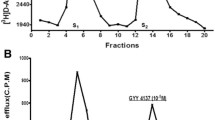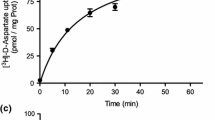Abstract
This study was undertaken in order to characterize the role of the glutamate/aspartate transporter (GLAST) in the glutathione (GSH) efflux induced by glutamate. Our results demonstrated that retinal cell cultures exhibit two mechanisms of GSH release, one Na+-independent and other Na+-dependent. Glutamate and aspartate induced GSH efflux only in presence of Na+. Treatment with PCD (L-trans-Pyrrolidine-2,4-dicarboxylate), a transportable glutamate uptake blocker, increased GSH release indicating that GSH can be carried by glutamate transporters in retinal cell cultures. Added to this, treatment with zinc ion cultures, a recognized inhibitor of GLAST blocked GSH efflux evoked by glutamate. Treatment with NMDA antagonist (MK-801) did not have any effect on the GSH release induced by glutamate. These results suggest that glutamate induces GLAST-mediated release of GSH from retinal cell cultures and this could represent an important mechanism of cellular protection against glutamate toxicity in the CNS.






Similar content being viewed by others
Abbreviations
- BSA:
-
Bovine serum albumin
- DMEM:
-
Dulbecco’s modified Eagle’s medium
- DTNB:
-
5,5,8-dithiobis-2-nitrobenzoic acid
- FBS:
-
Fetal bovine serum
- GLAST:
-
Glutamate-aspartate transporter
- MK-801:
-
(5R,2S)-(1)-5-methyl-10,11-dihydro-5H-dibenzo[a,d]cyclohepten-5,10-imine hydrogen maleate
- PDC:
-
L-trans-Pyrrolidine-2,4-dicarboxylate
- TNB:
-
Nitrobenzoic acid
References
Otori Y, Shimada S, Tanaka K et al (1994) Marked increase in glutamate-aspartate transporter (GLAST/GluT-1) mRNA following transient retinal ischemia. Brain Res Mol Brain Res 27:310–314
Derouiche A, Rauen T (1995) Coincidence of L-glutamate/L-aspartate transporter (GLAST) and glutamine synthetase (GS) immunoreactions in retinal glia: evidence for coupling of GLAST and GS in transmitter clearance. J Neurosci Res 42:131–143
Rauen T, Rothstein JD, Wässle H (1996) Differential expression of three glutamate transporter subtypes in the rat retina. Cell Tissue Res 286:325–336
Lehre KP, Davanger S, Danbolt NC (1997) Localization of the glutamate transporter protein GLAST in rat retina. Brain Res 744:129–137
Rauen T, Taylor WR, Kuhlbrodt K et al (1998) High-affinity glutamate transporters in the rat retina: a major role of the glial glutamate transporter GLAST-1 in transmitter clearance. Cell Tissue Res 291:19–31
Rauen T (2000) Diversity of glutamate transporter expression and function in the mammalian retina. Amino Acids 19:53–62
Bouvier M, Miller BA, Szatkowski M et al (1991) Electrogenic uptake of sulphur-containing analogues of glutamate and aspartate by Müller cells from the salamander retina. J Physiol 444:441–457
Handelman GJ, Dratz EA (1986) The role of antioxidants in the retina and retinal pigment epithelium and the nature of prooxidant induced damage. Adv Free Rad Biol Med 2:1–89
Tanito M, Nishiyama A, Tanaka T et al (2002) Change of redox status and modulation by thiol replenishment in retinal photo-oxidative damage. Invest Ophthalmol Vis Sci 43:2392–2400
Smythies JR (1997) Oxidative reactions and schizophrenia: a review-discussion. Schizophr Res 24:357–364
Jenner P (1998) Oxidative mechanisms in nigral cell death in Parkinson’s disease. Mov Disord 13:24–34
Jenner P, Olanow CW (1998) Understanding cell death in Parkinson’s disease. Ann Neurol 44:72–84
Jellinger KA (1999) The role of iron in neurodegeneration: prospects for pharmacotherapy of Parkinson’s disease. Drugs Aging 14:115–140
Yudkoff M, Pleasure D, Cregar L et al (1990) Glutathione turnover in cultured astrocytes: studies with [15 N]glutamate. J Neurochem 55:137–145
Sagara J, Makino N, Bannai S (1996) Glutathione efflux from cultured astrocytes. J Neurochem 66:1876–1881
Dringen R, Kranich O, Hamprecht B (1997) The gamma-glutamyl transpeptidase inhibitor acivicin preserves glutathione released by astroglial cells in culture. Neurochem Res 22:727–733
Hirrlinger J, Schulz JB, Dringen R (2002) Glutathione release from cultured brain cells: multidrug resistance protein 1 mediates the release of GSH from rat astroglial cells. J Neurosci Res 69:318–326
Stewart VC, Stone R, Gegg ME et al (2002) Preservation of extracellular glutathione by an astrocyte derived factor with properties comparable to extracellular superoxide dismutase. J Neurochem 83:984–991
Frade J, Pope S, Schmidt M et al (2008) Glutamate induces release of glutathione from cultured rat astrocytesa possible neuroprotective mechanism? J Neurochem 105:1144–1152
Kubrusly RCC, de Mello MC, de Mello FG (1998) Aspartate as a selective NMDA receptor agonist in cultured cells from the avian retina. Neurochem Int 32:47–52
de Almeida OMMS, Gardino PF, Santos NEL et al (2002) Opposite roles of GABA and excitatory amino acids on the control of GAD expression in cultured retina cells Brain. Research 925:89–99
Anderson ME (1985) Determination of glutathione and glutathione disulfide in biological samples. Methods Enzymol 113:548–555
Lowry OH, Rosebrough NJ, Farr AL et al (1951) Protein measurement with the Folin phenol reagent. J Biol Chem 193:265–275
Hayes KC (1974) Retinal degeneration in monkeys induced by deficiencies of vitamin E or A. Invest Ophthalmol 13:499–510
Organisciak DT, Wang HM, Li ZY et al (1985) The protective effect of ascorbate in retinal light damage of rats. Invest Ophthalmol 26:1580–1588
Sternberg P Jr, Lopez PF, Capone A Jr et al (1992) Management of threshold retinopathy of prematurity. Retina 12:60–63
Winkler BS, Giblin FJ (1983) Glutathione oxidation in retina: effects on biochemical and electrical activities. Exp Eye Res 36:287–297
Lash LH, Jones DP (1984) Renal glutathione transport. Characteristics of the sodium-dependent system in the basal-lateral membrane. J Biol Chem 259:14508–14514
Hagen TM, Jones DP (1987) Transepithelial transport of glutathione in vascularly perfused small intestine of rat. Am J Physiol 252:607–613
Kannan R, Kuhlenkamp JF, Jeandidier E et al (1990) Evidence for carrier-mediated transport of glutathione across the blood-brain barrier in the rat. J Clin Invest 85:2009–2013
Ballatori N, Dutczak WJ (1994) Identification and characterization of high and low affinity transport systems for reduced glutathione in liver cell canalicular membranes. J Biol Chem 269:19731–19737
Kannan R, Mittur A, Bao Y et al (1999) GSH transport in immortalized mouse brain endothelial cells: evidence for apical localization of a sodium-dependent GSH transporter. J Neurochem 73:390–399
Kannan R, Tang D, Hu J et al (2001) Glutathione transport in human retinal pigment epithelial (HRPE) cells: apical localization of sodium-dependent gsh transport. Exp Eye Res 72:661–666
McBean GJ (2002) Cerebral cystine uptake: a tale of two transporters. Trends Pharmacol Sci 23:299–302
Wang XF, Cynader MS (2000) Astrocytes provide cysteine to neurons by releasing glutathione. J Neurochem 74:1434–1442
Dringen R, Hirrlinger J (2003) Glutathione pathways in the brain. J Biol Chem 384:505–516
Bridges RJ, Stanley MS, Anderson MW et al (1991) Conformationally Defined Neurotransmitter Analogues. Selective Inhibition of Glutamate Uptake by One Pyrrolidine-2, 4-dicarboxylate Diastereomer. J Med Chem 34:717–725
Ohta K, Nomura T, Kanno T et al (2002) L-trans-PDC enhances hippocampal neuronal activity by stimulating glial glutamate release independently of blocking transporters. Biochem Biophys Res Commun 295:376–381
Shin J-W, Nguyen KTD POWDV et al (2009) Distribution of Glutamate Transporter GLAST in Membranes of Cultured Astrocytes in the Presence of Glutamate Transport Substrates and ATP. Neurochem Res 34:1758–1766
Bringmann A, Pannicke T, Biedermann B et al (2009) Role of retinal glial cells in neurotransmitter uptake and metabolism. Neurochem Int 54:143–160
Spiridon M, Kamm D, Billups B et al (1998) Modulation by zinc of the glutamate transporters in glial cells and cones isolated from the tiger salamander retina. J Physiol 506:363–376
Vandenberg RJ, Mitrovic AD, Johnston GA (1998) Molecular basis for differential inhibition of glutamate transporter subtypes by zinc ions. Mol Pharmacol 54:189–196
Gether U, Andersen PH, Larsson OM et al (2006) Neurotransmitter transporters: molecular function of important drug targets. Trends Pharmacol Sci 27:375–383
Acknowledgments
We would like to thank Makarú LTDA for supplying chicken eggs used in this work. This project was financially supported by CNPq and FAPESPA.
Author information
Authors and Affiliations
Corresponding author
Rights and permissions
About this article
Cite this article
Garcia, T.B., Oliveira, K.R.M., do Nascimento, J.L.M. et al. Glutamate Induces Glutathione Efflux Mediated by Glutamate/Aspartate Transporter in Retinal Cell Cultures. Neurochem Res 36, 412–418 (2011). https://doi.org/10.1007/s11064-010-0356-3
Accepted:
Published:
Issue Date:
DOI: https://doi.org/10.1007/s11064-010-0356-3




